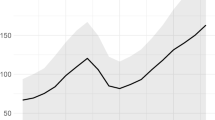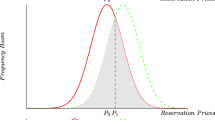Abstract
The significant price-trading volume correlation found in the residential property market presents a challenge to the rational expectation hypothesis. Existing theories account for this fact with either capital market imperfection (down-payment effect or loss-aversion consideration) or imperfect information (search theoretic models). This paper employs data from a commercial real estate market, which face a different degree of severity of capital market constraint than the residential market, and thus provide an indirect but effective test for alternative theories. Policy implications are also discussed.
Similar content being viewed by others
References
Anglin, P. M. (1997). “Bargaining with a Stochastic Number of Buyers,” University of Winsdor, Mimeo.
Anglin, P. M. (1999). “Testing Some Theories of Bargaining,” University of Winsdor, Mimeo.
Ball, M., C. Lizieri, and B. D. MacGregor. (1998). The Economics of Commercial Property Markets. London and New York: Routledge.
Berkovec, J., and J. Goodman. (1996). “Turnover as a Measure of Demand for Existing Homes,” Real Estate Economics 24, 421–440.
Brown, G. R., and K. W. Chau. (1997). “Excess Returns in the Hong Kong Commercial Real Estate Market,” Journal of Real Estate Research 14(1–2), 91–105.
Chau, K. W., S. K. Wong, and C. Y. Yiu. (2004). “Adjusting for Non-linear Age Effects in the Repeat Sales Index,” Journal of Real Estate Finance and Economics 31(2), 137–153.
Chen, N.-K. (2001). “Bank Net Worth, Asset Prices and Economic Activity,” Journal of Monetary Economics 48, 415–436.
Cheng, H. F. E. (2001). “Essays on Commercial Property Market: Macro and Micro Views,” Unpublished Master Thesis, The Chinese University of Hong Kong.
Chow, Y. F., C. K. Y. Leung, N. Wong, E. H. F. Cheng, and W. H. Yan. (2002). Hong Kong Real Estate Market: Facts and Policies, Hong Kong: Ming Pao Publishing (in Chinese).
Christiano, L. J., and T. J. Fitzgerald. (1998). “The Business Cycle: It’s Still a Puzzle,” Federal Reserve Bank of Chicago Economic Perspectives 22(4), 56–83.
Dokko, Y., R. H. Edelstein, A. J. Lacayo, and D. C. Lee. (1999). “Real Estate Income and Value Cycles: A Model of Market Dynamics,” Journal of Real Estate Research 18(1), 69–95.
Dombrow, J. J. R. Knight, and C. F. Sirmans. (1997). “Aggregation Bias in Repeat-Sales Indices,” Journal of Real Estate Finance and Economics 14, 75–88.
Efron, B., and R. J. Tibshirani. (1993). An Introduction to the Bootstrap. Chapman & Hall.
Feng, D. (2003). “Price-Trading Volume Correlation of the Hong Kong Office Property Market,” Unpublished Master Thesis, The Chinese University of Hong Kong.
Fisher, J. D. Gatzlaff, David Geltner, and Donald Haurin. (2003). “Controlling for Impact of Variable Liquidity in Commercial Real Estate Price Indices,” Real Estate Economics 31(2), 269–303.
Follain, J. R., and O. T. Velz. (1995). “Incorporating the Number of Existing Home Sales into a Structural Model of the Market for Owner-Occupied Housing,” Journal of Housing Economics 4, 93–117.
Genesove, D. (2003). “The Nominal Rigidity of Apartment Rents,” Review of Economics and Statistics 85(4), 844–853.
Genesove, D., and C. J. Mayer. (2001). “Nominal Loss Aversion and Seller Behavior: Evidence from the Housing Market,” Quarterly Journal of Economics 116, 1233–1260.
Greene, W. (2000). Econometric Analysis, Fourth edition. New Jersey: Prentice Hall.
Hanushek, E., S. Rivkin, and L. Taylor. (1996). “Aggregation and the Estimated Effects of School Resources,” Review of Economics and Statistics 78, 611–627.
Hort, K. (1999). “Prices and Turnover in the Market for Owner-occupied Homes,” Regional Science and Urban Economics 30, 99–119.
Iacoviello, M. (2002). “House Prices, Borrowing Constraints and Monetary Policy in the Business Cycle,” Boston College Working Paper No. 542.
Kan, K., S. K.-S. Kwong, and C. K.-Y. Leung. (2004). “The Dynamics and Volatility of Commercial and Residential Property Prices: Theory and Evidence,” Journal of Regional Science 44, 95–123.
Kiyotaki, N., and J. Moore. (1997). “Credit Cycles,” Journal of Political Economy 105, 211–248.
Kocherlakota, N. R. (1996). “The Equity Premium: It’s Still a Puzzle,” Journal of Economic Literature 34(1), 42–71.
Kwong, S. K. S., and C. K. Y. Leung. (2000). “Price Volatility of Commercial and Residential Property,” Journal of Real Estate Finance and Economics 20(1), 25–36.
Lamont, O., and J. C. Stein. (1997). “Leverage and Housing-Price Dynamics in U.S. Cities,” NBER Working Paper 5961.
Lau, C. K. G. (2001). “Hong Kong Property Market: The Correlation Between the Trading Volume and the Rate of Return,” Unpublished Master Thesis, The Chinese University of Hong Kong.
Leung, C. K. Y., and D. Feng. (2004). “Testing Alternative Theories of Property Price-Trading Volume Correlations with Commercial Property Market Data,” Mimeo, Chinese University of Hong Kong.
Leung, C. K. Y., G. C. K. Lau, and Youngman C. F. Leong. (2002a). “Testing Alternative Theories of the Property Price-trading Volume Correlation,” Journal of Real Estate Research 23, 253–263.
Leung, C. K. Y., Y. C. F. Leong, and I. Y. S. Chan. (2002b). “TOM: Why Isn’t Price Enough?” International Real Estate Review 5, 91–115.
Leung, C. K. Y., Y. C. F. Leong, and Y. W. Y. Cheng. (2004). “Does a Financial Crisis Change the Demand for Housing Attributes,” Paper Presented at the AsRES Meeting.
Lo, A. W., and J. Wang. (2000). “Trading Volume: Definitions, Data Analysis, and Implications of Portfolio Theory,” Review of Financial Studies 13(2), 257–300.
Lucas, R. (1978). “Asset Prices in an Exchange Economy,” Econometrica 46, 1426–1445.
Ortalo-Magne, F., and S. Rady. (1998). “Housing Market Fluctuations in a Life-cycle Economy with Credit Constraints,” Stanford University Graduate School of Business Research Paper 1501.
Ortalo-Magne, F., and S. Rady. (1999). “Boom In, Bust Out: Young Households and the Housing Price Cycles,” European Economic Review 43, 755–766.
Smith, B., and J. M. Campbell. (1978). “Aggregation Bias and the Demand for Housing,” International Economic Review 19, 495–505.
Stein, J. C. (1995). “Prices and Trading Volume in the Housing Market: A Model with Down-Payment Effects,” Quarterly Journal of Economics 110, 379–405.
Wheaton, W. C. (1987). “The Cyclic Behavior of the National Office Market,” Journal of the American Real Estate and Urban Economics Association 15(4), 281–299.
Wheaton, W. C. (1990). “Vacancy, Searched Prices in a Housing Market Matching Model,” Journal of Political Economy 98, 1270–1292.
Author information
Authors and Affiliations
Corresponding author
Rights and permissions
About this article
Cite this article
Leung, C.K.Y., Feng, D. What Drives the Property Price-Trading Volume Correlation? Evidence from a Commercial Real Estate Market. J Real Estate Finan Econ 31, 241–255 (2005). https://doi.org/10.1007/s11146-005-1374-9
Published:
Issue Date:
DOI: https://doi.org/10.1007/s11146-005-1374-9




